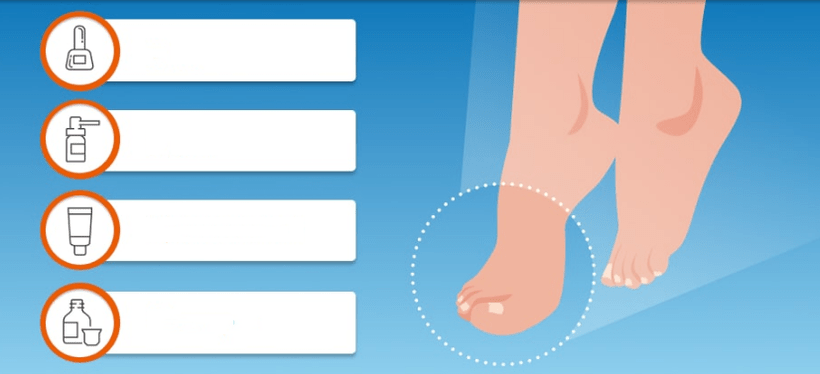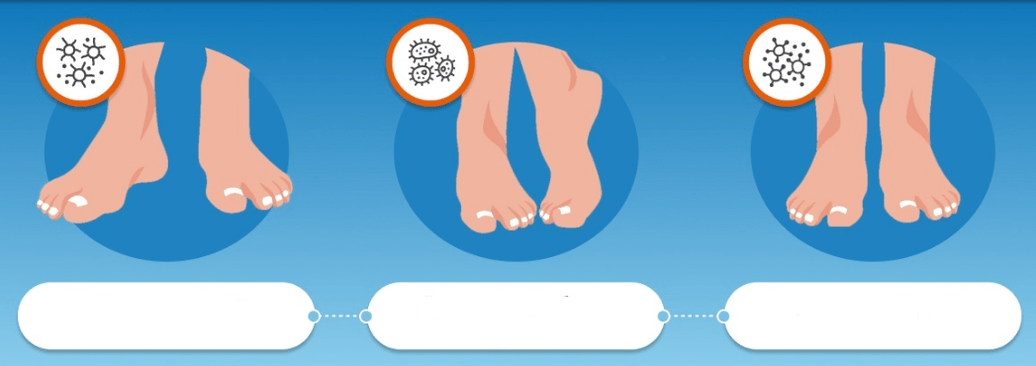Nail fungus (onychomycosis) is diagnosed on average in 10-15% of the world population, and among people over the age of 60 the incidence reaches 30-50%. Men suffer 1. 3 times more often than women, which is probably due to an insufficiently responsible attitude towards the problem. It is difficult to get rid of nail fungus, but it is possible, and the main task of the doctor and the patient is to choose the right remedy for nail fungus. Let's talk about what drugs are and how they work.
Is therapy necessary for fungi?
Many people, especially the elderly, neglect the treatment of the fungus, believing that this problem is only aesthetic and, apart from a cosmetic defect, does not cause any consequences. This is a rather dangerous misunderstanding. We explain why.
First, the fungus is extremely contagious. If you don't pay attention to treatment, the infection spreads quickly. The causative agents of onychomycosis are easily transmitted through household items and the patient runs the risk of infecting the entire family.
Secondly (and most importantly), the nail fungus problem is by no means just aesthetic. A neglected disease significantly reduces the quality of life: pain appears, difficulties arise with the choice of shoes and all kinds of household inconveniences. The nail plate, affected by the fungus, can collapse over time. But that's still half the problem. Without timely and proper treatment, nail fungus damages the entire body. The risk of allergies increases (due to the developing hypersensitivity to fungi and their metabolic products), infectious complications (for example, erysipelas) often join. Against the background of onychomycosis, any skin diseases are more serious. Not to mention, chronic infection weakens the immune system.
So the answer is unambiguous: it is necessary to treat the nail fungus and as soon as possible. The further the process went, the harder it is to get rid of the disease. Therefore, therapy should ideally be started at the first sign of injury. Another problem is how to treat. The variety of drugs is so great that it is easy to get confused. But you need to know how they work to understand which remedy helps get rid of nail fungus. We'll talk about it.
Choose a remedy for nail fungus
On the net you can find many tips for fighting fungi. Traditional medicine recommends getting rid of it with the help of soda, ammonia, propolis, kerosene, celandine juice, essential oils. There are recipes for nail fungus remedies with vinegar, iodine, hydrogen peroxide. By resorting to such seemingly harmless home methods, the patient only aggravates the problem. Not a single traditional medicine destroys the pathogens of onychomycosis, and the lesion progresses, covering an increasing area of the nail plate. Eventually, the patient ends up in the dermatologist's office with an advanced fungus that is very difficult to cure.
So tip number one: no self-treatment! If signs of the disease are found, you should contact a dermatologist who will prescribe an effective drug for nail fungus. Self-medication is unacceptable, if only because onychomycosis is caused by different types of pathogens, and in any case it is important to choose the right active ingredient. And in order not to doubt the recommendations of a specialist, it is worth knowing how they work and how the drugs used to treat this disease differ from each other.
Means for the treatment of nail fungus can be classified according to the form of release and the active substance. Among other selection criteria, price category and ease of use matter.
Release form
External preparations against nail fungus are produced in the form of varnish, spray, cream (ointment) and solution.

Antifungalpaints, as a rule, women prefer, because with the help of such products it is possible to combine treatment with cosmetic care. Before processing, it is necessary to smooth the surface of the nail plate with a file. After applying the medical paint, you can use the decoration. This is the main advantage of this dosage form.
However, paints are not universal. First, they are effective only with a small area of damage. If the fungus has spread to more than a third of the nail plate, the remedy will not help. Secondly, the drug in the form of paint can cope only with superficial mycosis. This is because it cannot penetrate the lower layers of the nail. With a deep lesion, when the nail plate thickens, the antifungal agent in the form of enamel will not work - a stronger drug is needed.
Cream and spray- similar forms: both oil-based. They are ideal for the treatment of cutaneous mycoses, which, among other things, often accompany nail fungus. The tool easily penetrates into the lower layers of the epidermis, destroying the pathogen. But the nail has a denser structure, and the oil-based preparation does not reach all infection sites. The cream or spray is best used as an auxiliary part of the treatment of onychomycosis - with concomitant fungal infections of the skin of the feet.
Solution- the optimal form of antifungal agent for nails. The drug based on alcohol and water penetrates deep into the nail plate, filling the voids and channels through which the pathogen spreads. Therefore, the fungicidal and fungistatic effect of the liquid remedy for nail fungus is stronger than in other forms.
Active substance
Preparations against fungi are mainly substances of synthetic (rarely natural) origin, having a different chemical structure. Depending on this, the spectrum of their activity differs, that is, the action against certain pathogens. Since onychomycosis can be caused by different types of pathogenic fungi, the correct choice of the active ingredient is very important.

Note
To reliably establish the type of pathogen, it is necessary to conduct a microbiological study of a tissue fragment. But you can usually determine the type of fungus from the external characteristics of the affected nail. The most common causative agent of onychomycosis is Trichophyton Rubrum. Less commonly, the disease is caused by other types of dermatophytes, yeast-like fungi, and molds.
In terms of chemical structure, there are several groups of antifungal drugs:
Poliena. These include substances such as nystatin, levorine, amphotericin. When taken orally, they are active against many types of fungi, but topical application of these agents is only effective for candidiasis. Therefore, polyenes are usually not prescribed for the treatment of onychomycosis.
azoles. For external use, drugs based on the substances clotrimazole, econazole, miconazole, oxiconazole, isoconazole, bifonazole are used. Their action is predominantly fungistatic - in other words, these drugs block the development of the fungus. The fungicidal effect (destruction of the pathogen) is possible when high concentrations of the substance are reached in the tissues. Azoles are active against Candida yeast-like fungi and dermatomycetes, which cause skin lesions. With nail fungus, these drugs are not very effective.
Allylamines. This is the main group of antifungal agents prescribed for the treatment of mycoses of the skin and nails. For topical use, terbinafine and naftifine-based products are suitable. The first is also prescribed orally in an advanced stage of the disease. Naftifine is an effective treatment for nail fungus. It exhibits fungicidal activity against dermatophytes (including Trichophyton Rubrum), yeasts and molds - in a word, the main possible causative agents of fungal nail infections. In addition, naftifine acts on many bacteria.
Among other substances not included in these groups, amorolfine and ciclopirox are used to treat onychomycosis. Both drugs are applied topically, mainly as part of antifungal paints.
Ease of use
Getting rid of the fungus is a long process. For several months, nail treatment will become a daily procedure, otherwise a positive result will not be obtained. Given the duration of the treatment, it is important to choose a tool that is comfortable to use. In the case of varnish, it should be borne in mind that the surface of the nail must be sanded before each use. Therefore, it is good if there are disposable files in the kit. In the case of a solution, it is preferable to choose a product packaged in a sealed bottle with a dropper cap. The elongated dropper nose is more convenient for spot application of the solution where it can penetrate deep into the nail plate. This form is optimal in dosage - it is easy to measure and apply the required amount of the drug, which makes consumption more economical.
Packaging and cost of the course
Treatment of the fungus should be continued until the full growth of a healthy nail plate. With nail fungus of the hands, this process takes about four months. Toenails grow slower on toenails and can take up to a year to heal. So the purchase of an antifungal agent is not a one-time expense, but a normal expense item and, of course, I want to reduce it as much as possible. However, the desire to save must not prevail: the main selection criterion is efficiency. A reasonable decision is to focus on the active ingredient. Sometimes this allows you to choose an analogue of a widely advertised drug that is equal in effectiveness, but more profitable in price.
Onychomycosis not only reduces the quality of life, but also threatens serious complications. Therefore, when the first signs of infection are detected, it is necessary to consult a doctor as soon as possible and start treatment.remedies against toenail and hand fungus with clinically proven efficacy.
Nail fungus solution
To combat nail fungus, you can use the drug in the form of a solution. The active ingredient of the drug is naftifine, a substance from the allylamine group, active against most types of pathogenic fungi. Destroys dermatophytes (Trichophyton, Epidermophyton, Microsporum), Candida yeast fungi, Aspergilla molds and other types of nail and skin fungal pathogens. The drug in the form of a solution penetrates the thickness of the nail plate, moves along the path of spread of the fungus and creates stable concentrations of the drug in the area of accumulation of infection.
The action of the drug is fungicidal, that is, it not only stops the development of the fungus, but destroys it.
In addition, naftifine has antibacterial activity. Fungal diseases of the nails and skin are often complicated by bacterial infections, and the use of the drug can solve both problems at the same time.
An additional effect of naftifine is anti-inflammatory. It helps reduce the redness, swelling, and itching that often accompany a fungal infection.
Indications for the use of the solution include fungal infections not only of the nail plate, but also of smooth skin, skin folds and interdigital lesions, as well as candidiasis, pityriasis versicolor, inflammatory dermatomycosis. The same range of indications for other products in the line - cream and spray.
























